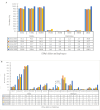Prevalence of molecular markers of sulfadoxine-pyrimethamine resistance in Plasmodium falciparum isolates from West Africa during 2012-2022
- PMID: 39496624
- PMCID: PMC11535326
- DOI: 10.1038/s41598-024-75828-w
Prevalence of molecular markers of sulfadoxine-pyrimethamine resistance in Plasmodium falciparum isolates from West Africa during 2012-2022
Abstract
Sulfadoxine-pyrimethamine (SP) is a key drug recommended by the World Health Organization for the chemoprevention of malaria. However, the strategy is affected by the parasite resistance to SP. This study evaluated Plasmodium falciparum dihydrofolate reductase (Pfdhfr) and dihydropteroate synthase (Pfdhps) genes, associated with SP resistance, from 508 P. falciparum isolates imported from West African countries to Henan Province, China, during 2012-2022. High mutant prevalence of the genes Pfdhfr (94.7%) and Pfdhps (96.8%) was observed. The mutants Pfdhfr N51I, C59R, S108N, and Pfdhps A437G were at high frequency in all countries analyzed. The overall prevalence of the mutant Pfdhps K540E was low (3.4%), but with a high frequency in Liberia (24.3%). The frequency of mutants Pfdhps I431V, A581G, and A613S was 11.7%, 9.8%, and 16.2%, respectively, all of which had the highest mutant prevalence in Nigeria. The mutant Pfdhps A581G and A613S were identified in the absence of K540E. The partially resistant haplotype (I51R59N108 - G437) was the most common (72.6%), and the fully resistant haplotype (I51R59N108 - G437E540) had a low prevalence of 3.4% and mainly occurred in Liberia. No super resistant haplotype was identified. The mutant Pfdhps I431V and the octuple mutant haplotype I51R59N108 - V431A436G437G581S613 deserve more attention. In areas of high SP resistance, the intervention still reduces low birthweight and maternal anaemia. SP should continue to be used in areas of high SP resistance until more effective alternatives for malaria chemoprevention are found. It is important to continuously monitor the molecular markers associated with SP resistance to better implement intermittent preventive treatment policies in pregnancy (IPTp) and infants (IPTi).
© 2024. The Author(s).
Conflict of interest statement
The authors declare no competing interests.
Figures
Similar articles
-
Prevalence of Plasmodium falciparum parasites resistant to sulfadoxine/pyrimethamine in pregnant women in Yaoundé, Cameroon: emergence of highly resistant pfdhfr/pfdhps alleles.J Antimicrob Chemother. 2015 Sep;70(9):2566-71. doi: 10.1093/jac/dkv160. Epub 2015 Jun 16. J Antimicrob Chemother. 2015. PMID: 26080363
-
Low prevalence of highly sulfadoxine-resistant dihydropteroate synthase alleles in Plasmodium falciparum isolates in Benin.Malar J. 2021 Feb 5;20(1):72. doi: 10.1186/s12936-021-03605-5. Malar J. 2021. PMID: 33546703 Free PMC article.
-
High prevalence of Pfdhfr-Pfdhps quadruple mutations associated with sulfadoxine-pyrimethamine resistance in Plasmodium falciparum isolates from Bioko Island, Equatorial Guinea.Malar J. 2019 Mar 26;18(1):101. doi: 10.1186/s12936-019-2734-x. Malar J. 2019. PMID: 30914041 Free PMC article.
-
Evolution of Pfdhps and Pfdhfr mutations before and after adopting seasonal malaria chemoprevention in Nanoro, Burkina Faso.Sci Rep. 2024 Oct 16;14(1):24224. doi: 10.1038/s41598-024-75369-2. Sci Rep. 2024. PMID: 39414909 Free PMC article.
-
Prevalence of antimalaria drug resistance-conferring mutations associated with sulphadoxine-pyrimethamineine-resistant Plasmodium falciparum in East Africa: a systematic review and meta-analysis.Ann Clin Microbiol Antimicrob. 2025 Apr 16;24(1):25. doi: 10.1186/s12941-025-00795-7. Ann Clin Microbiol Antimicrob. 2025. PMID: 40241183 Free PMC article.
References
-
- World Health Organization. World Malaria Report 2022. https://www.who.int/publications/i/item/9789240064898 (2023).
-
- Bjorkman, A. & Phillips-Howard, P. A. The epidemiology of drug-resistant malaria. Trans. R Soc. Trop. Med. Hyg.84, 177–180. 10.1016/0035-9203(90)90246-b (1990). - PubMed
-
- World Health Organization. WHO policy brief for the implementation of intermittent preventive treatment of malaria in pregnancy using sulfadoxine-pyrimethamine (IPTp-SP). https://www.who.int/publications/i/item/WHO-HTM-GMP-2014.4 (2013).
MeSH terms
Substances
Grants and funding
LinkOut - more resources
Full Text Sources


